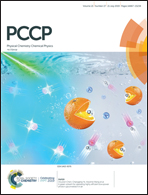Biaxial strain effect on the electronic structure and valleytronic properties of a MoS2/CoO(111) heterostructure
Abstract
The biaxial strain effect on the electronic structure and valleytronic properties, such as valley splitting and Berry curvature, of monolayer MoS2 induced by the magnetic proximity effect of an antiferromagnetic CoO(111) substrate is investigated by density functional theory. The biaxial tensile strain could continually tune the magnitude of spin and valley splitting of the MoS2/CoO(111) heterostructure, because the spin splitting at the K and K′ valleys decreases, whereas the valley splitting increases slightly in the tensile strain range of 0–6%. The ferromagnetic order of MoS2 in the heterostructure induced by the magnetic CoO substrate is retained under a biaxial tensile strain of 2% to 6% compared with the unstrained case. In particular, the intensity of the exchange field due to the magnetic proximity effect of CoO weakens monotonously with biaxial tensile strain increasing from 0% to 6%, thereby also leading to a monotonous reduction of the Berry curvature. The regulation of valley splitting and Berry curvature by biaxial tensile strain will provide the MoS2/CoO(111) heterostructure with high potential in future valleytronic applications.



 Please wait while we load your content...
Please wait while we load your content...